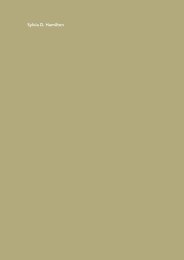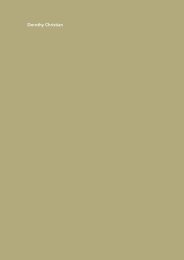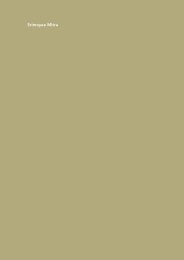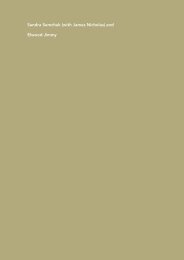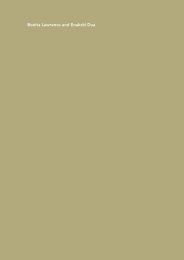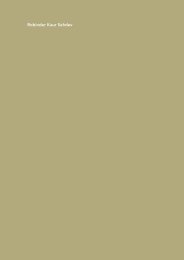Ashok Mathur - Speaking My Truth
Ashok Mathur - Speaking My Truth
Ashok Mathur - Speaking My Truth
- No tags were found...
Create successful ePaper yourself
Turn your PDF publications into a flip-book with our unique Google optimized e-Paper software.
<strong>Ashok</strong> <strong>Mathur</strong>
<strong>Ashok</strong> <strong>Mathur</strong> is a writer, educator, and cultural organizer interested in new modelsof artistic research and interdisciplinary collaboration. He is Canada Research Chairin Cultural and Artistic Inquiry at Thompson Rivers University (Kamloops, BritishColumbia) where he directs the Centre for innovation in Culture and the Arts in Canada(CiCAC), a creative think-tank looking at progressive models of research. He is alsoAssociate Professor, cross-posted to the departments of Visual and Performing Artsand Journalism, Communications, and New Media at TRU. His research interests arein critical/creative practices that pursue a social justice agenda. He has published fourbooks that address, through creative writing, the underpinnings of race, reconciliation,and the politics of gender and sexuality, and he also addresses these issues throughartistic practices blending text with installation. His publications include a poetic novella,Loveruage: a dance in three parts (Wolsak and Wynn Publishers Ltd., 1994), and threenovels: Once Upon an Elephant (Arsenal Pulp Press, 1998), The Short, Happy Life ofHarry Kumar (Arsenal Pulp Press, 2001), and A Little Distillery in Nowgong (Arsenal PulpPress, 2009). This last novel was simultaneously developed into a collaborative, crossdisciplinaryinstallation project that exhibited across the country and was part of theyear-long DIASPORArt show at Rideau Hall, official residence of the Governor Generalof Canada, featuring culturally diverse artistic practices. <strong>Ashok</strong> was born in Bhopal,India, to a Hindu (Kyasth) father and a Parsi mother, and was raised in Nova Scotia andAlberta. These factors of family, migration, and hybrid cosmology figure prominently inhis creative and critical practices. Since the early 1990 s, he has worked within diversecultural sectors in Canada and abroad, including Aboriginal, immigrant, and otherracialized communities. His current work investigates the historical undercurrents ofrace and reconciliation, locally and internationally.
Cultivations, land, and a politics of becomingWhen my parents immigrated to Canada with two young children in tow,it was with the bright promise of arriving in a new land, finding a place tocall home, and putting down roots in a country far from familial historiesand ancestral birthrights. If this isn’t the dream shared by all immigrants,it does approximate the sensations and parallels the trajectories taken bythose who come, through will or circumstance, leaving behind history andwalking into what we believe, for all intents, to be a tabula rasa. It is notwithout a hint of irony that I acknowledge the language of ‘newness’ andthe notion of settling on a pristine landscape as part of this immigrantdreamscape. Of course, a more appropriate metaphor than a blank slatewould be a geographic palimpsest, a land whose history is always alludedto by the tracings and markings that, however obscured or willfully ignored,can never be erased. This is the land we came to, not a terra nullius but aland weighted with official and unofficial histories, some of which newimmigrants were made to understand quite well, and others which remainedand remain un-interrogated. Compounding the complexity, after the initialwave of colonizing settlers from western Europe, increasing numberswere arriving from Asia and Africa, constituting an ever-larger group ofnon-white immigrants. When we enter into the political jurisdiction ofCanada, we acknowledge the Crown, and through it, an explicit history ofempire, colonial enterprise, and global interconnections. But we all too oftenremain blithely unaware of histories inscribed into the land that far predateConfederation and both British and French incursions onto this terrain.And if there is any awareness of First Peoples and their inhabitation andproprietorship of this land, it is most frequently mediated through colonialnarratives of contact (and concomitant anthropological assumptions ofpre-contact histories), such that the racialized immigrant’s awarenessof Aboriginality is almost always pre-configured through a colonial gaze.Layered upon this is the familiarity with contexts of oppressive historiesfrequently experienced by immigrants and their descendants, either acts ofaggression committed by dominant communities or governments in formerhomelands, or those perpetrated post-arrival to these shores—persecutionof African diasporic peoples, internment of Japanese Canadians, repressiveCultivating Canada | 3
laws that targeted racialized communities, to name but a few instancesaddressed far more thoroughly in the articles that are contained in this volume.But I want here to return to the very idea of the land. Unaware of theaforementioned palimpsestic nature of the place we ended up inhabiting,my family settled in the suburbs on the southern edge of Calgary. The solebus route to the downtown core terminated several blocks north of ourhome in a gravel turnaround; and while our neighbourhood was not exactlybeing built up around us, immediately adjacent communities were still rifewith non-landscaped lots and newly planted poplars. Sod was laid downto cover mounds of freshly turned earth, the lines between the squaresgradually fading over those first springs and warm summers, creating thatpeculiar uniformity so desired in middle-class suburban landscapes. Eventhe schools sprung up around us just in time to educate growing families—my older sister had the unique high school perspective of always being inthe senior class, since the school opened at first only to house an initialintake of grade ten and laddering over the next two years to eventuallygraduate its first cohort of grade twelve students. Despite its beginningsas an almost all-white suburb, the growth of the city brought immigrants(and transplanted Canadians) that gradually shifted the racial mix. Butthrough the fissures of suburban experiences and cultural shifts, the landstill seeped through. Just a couple of miles to the west of this high school,the wide Albertan road turned narrow and winding, crossing over a smallbrook into a treed region where a small wooden sign indicated to travellersthey were now on (what was then called) the Sarcee Reserve. On weekendoutings we would take the TransCanada to Banff, the jewel of the provincialtourism crown, barely noticing the black-lettered sign halfway to thefoothills noting that we were passing through Stoney land. And if the carwere to turn a hundred and eighty degrees and travel eastward instead, assoon as the mountains became indistinct in the rearview mirror, loomingon the horizon was an ominous brick building on the prairie that I wouldfind out many years later was Old Sun, the residential school on Blackfootterritory. So this was our knowledge of Calgary, a suburb where everyoneseemed transported from somewhere else—but a short distance away wasclearly not the city at all, not a Canada we knew, and certainly not one wehad the tools to recognize. Language and nomenclature changed as theyears passed—the Sarcee sign was replaced with one announcing the TsuuT’ina Nation, and while Old Sun remained standing, it became a universityoutreach site on the Siksika Nation—but the land persisted.Growing up in Calgary, amidst urban landscaping embedded in theprairie landscape all situated within the context of three First Nations, thecomplexity of these multiple layers eluded me, but the contradictions of4 | <strong>Ashok</strong> <strong>Mathur</strong>
misidentification did not. This was some years before it became an acceptedpractice, for reasons of clarity and geographic rather than nationalisticidentity, to call oneself “South Asian,” a reference to a point of origin ofa subcontinent rather than a geopolitical state. Yet back on that prairielandscape, within a tight and growing expatriate population from India,everything from food to dress to custom was all too readily adjectivizedwith “Indian,” which was simple enough to understand within that firstgenerationhomogeneous community. But in that all-too-altered secondgeneration, where differentiations of manner, language, and accent wereameliorated through a peer-informed culture, this same modifier renderedquite surprisingly. Here, the brown child who walked and talked and dressedlike his classmates, yet called himself “Indian,” was a unique creature indeed.Slippage of history and identity, a mismatched nomenclature that, truth betold, was inaccurate for both the South Asian and Aboriginal body, a namethat stuck through misunderstandings and misappropriations. Nonetheless,there I was, an Indian in Calgary, in a place and time where such an identitystood in binary opposition to “Cowboy” and where the only way a youngchild could try to correct his misinformants was, curiously enough, byusing the very same adjective to modify the noun: “No, not that kind ofIndian; I’m an Indian Indian.” That was, perhaps, the first point of cominginto being by identifying both by who or what I was and was not. In suchnegative cogitation, I was left with the burning question of who this Indianmight be, imagined and projected upon my body, and yet otherwise (in myneighbourhood, community, consciousness) so completely absent.The same mis-identity became even more apparent when, as a fresh graduatefrom photojournalism school, I toured southern Alberta rodeos, a differentbut no less absurd version of the cowboy/Indian dichotomy. However, here iswhere I found out something quite real about the notion of place and land, ofwho went where, and why. I found out about reserves as I talked to people atpowwows and band offices that seemed a distant remove from those I hadlearned about in high school history classes where voyageurs opened upthe fur trade with their ‘contacts,’ and various textbook alliances resulted inconflicts small and large between French and British. This was something else,something in and of the land. But this reality did not truly come to mind until Iwas all but finished my Master’s degree in English and, in the weeks before mydefense, I was offered the chance to teach a course (a full course of my own, forthe first time), not at the university, but a first-year transfer English course tobe offered out at Old Sun on the Siksika Nation. Situated exactly 100 kilometreseast of the university carpool where I received a vehicle each week, Old Sunwas where I first set foot into what was once a residential school. It was an oddexperience; the English teacher who came in from the city campus (where,Cultivating Canada | 5
ironically enough, students from Siksika had to venture out once per week tolearn Blackfoot as it was only taught as a university credit in Calgary) to talkabout how to study literature by looking at a handful of novels and short storieswritten over the past two centuries. I vividly remember trying to get into theshared faculty office one day to retrieve my textbooks, only to find it locked,and being suddenly and severely chastised by another teacher, a middle-agedwhite guy, for trying to get into ‘his’ office. I apologized, thinking that perhapsthis was not shared faculty space after all, but still he glared at me for trying togain access. It was only later in the day that he passed by my classroom, saw meleading discussions, and came to me after, offering his own profuse apologies:“I’m so sorry: I thought you were a student.” These words resonated with mefor some time after—as a student, I was deserving of rebuke, but as a ‘fellow’faculty member, I was deserving of apology. Strange misidentifications again,as more than once students and faculty mistook me for a different kind ofIndian, again igniting in me the curiosity of what it meant to be in a place, butnot of a place, and the rights and privileges thus afforded.Years later, in a different incarnation yet again, I found myself working invisual and literary arts both in educational and organizational capacities,wondering about the connections forged (and not) and the relationshipsconceived of (or not) between official multiculturalism and Aboriginalpolicies as perceived by a government and general populace. In those headydays of identity politics, particularly in the arts, where the struggle was bothone of expression and visibility, it seemed like there were such barriers. Iremember even resurrecting the misnomers of my childhood, teaching aninternational literature course at the Alberta College of Art and Design andexploring the contents of South Asian and First Nations novels in this IndianIndian course. Or the troubles that ensued when the Minquon Panchayatcame together in 1992 to challenge the white autocracy of the artist-runcentre scene in Canada, its very name and membership comprised of ablend of Aboriginal and immigrant, racialized and radicalized in extremis,an exercise in both alliance and inner contestations. All of this, a fertile(yet sometimes feeling futile) landscape that invited further, deeper, andevermore complex matrices of coming to terms, coming of age, in a placewhere histories are elided, ignored, or overly emphasized, all depending onthe desire of the day, the whims of those who hold sway.When the Aboriginal Healing Foundation first approached me to edit this,the third of three volumes addressing the complexities of reconciliationin Canada, I was asked to develop an anthology that could bring in non-Indigenous voices to somehow widen the breadth of the current discourseson the issue that, to date, have largely centred on the difficult binary ofcolonizer and colonized, of White settlers and Aboriginal peoples. The6 | <strong>Ashok</strong> <strong>Mathur</strong>
central desire, it seemed, was to solicit the words from different centresof investment—immigrant, racialized, ‘new’ Canadians, and otherminoritized communities—whose stories thus far had gone, if not untold,then largely unnoticed. How do such communities relate to the intricacies ofreconciliation as a concept, not just of Aboriginal histories, but of differenttrajectories that have led to the current configuration and conglomeration ofpeoples on this land? Pronouncements of official bilingualism, multiculturalmosaics, and typically national attributes of politeness and compassionoften overdetermine what it means to be a Canadian citizen. But our bodiesand our lives are as marked by the invisible (or invisibilized) testimoniesthat circulate around and through, naming us through an absence thatcharges us with a moral obligation to resist the quietude that is otherwiseencouraged by the parliamentarians of passive democracies, and to reactand respond as critical and creative agents. This is no easy task within aneconomy that thrives on paths of least resistance in favour of troubling,unsettling analyses that disrupt if not uproot histories. Simply put, ourcurrent codes of success suggest we put the past behind us, blinker ourselvesas we negotiate transit to the future, unencumbered by the unseemlyrealities that, were they given attention, might discomfit and derail usfrom our chosen destiny. The question to be asked, then, is how can wepossibly come into being if we refuse the hauntings of the past, favouringofficial retellings of history that inscribe a singularity, a unity that beliesthe fragmented and disharmonious realities that are at once far morehonest as much as they are contradictory and fractious? Perhaps this is botha rhetorical and unanswerable question, but it seems that investigatingthis process, at the very least, is the only way to begin to understand thevectoring of the past.Cultivating Canada: Reconciliation through the Lens of Cultural Diversityis an attempt at such a beginning. From its conception, this book defieda linear description. Indeed, constructing the very title was an ongoingexercise as we struggled to find the words that encapsulated withoutrestraining the ideas this book would contain. Acknowledging thecentrality of the idea of land meant that the title should reflect this withoutre-inscribing simplified tropes of belonging and proprietorship, and yetwe also wanted—needed—to address the vast historical and migrationalcomplexities of working on, with, and in this geographic space. As withother elements of this anthology, it was artistic practice that lit the way.Upon studying the potential cover images from Henry Tsang’s NapaNorth project—through gritty images juxtaposing scenic landscapes,urban development, and agriculture that addresses the complexities ofIndigenous histories and post-contact culture—it became clear that whatCultivating Canada | 7
was at the heart of the matter here was a viewing and reviewing of thephysical landscape around us as both a metaphor and a reality. While thecold light falling across the orchards in the cover image might present aliteral cultivation (with all its attendant pros and cons), looking deeper wecan see the possibilities afforded by a nurturing hand. A metaphorical andcollaborative turning of the soil allows us, through and from a variety ofdiverse lenses, to perceive with new eyes, perhaps to recreate a vision thatwill bring us closer to understanding both our collective and disparatepasts and our possible and potential futures. Riel is often credited withinsisting that creative visionaries among his people will lead the way outof troubling times. He spoke particularly to and about the Métis of the land,and while this anthology stands as testament that our complex realities mayonly benefit from the participation of artists who can see past the clinicaland analytical approaches,it is incredibly useful, but may only be a partialsolution to the circumstance of reconciliation.Like many multi-authored anthologies, this one does, of course, exceedthe sum of its parts; yet these parts—the individual contributions fromacademics, writers, artists—are often in and of themselves beyond a singularthesis. While all of them take on the notion of reconciliation in at least atacit manner, their methods and modalities range remarkably. Where thefirst two volumes in the series directly addressed the history, legacy, andconsequences of Indian residential schools and the <strong>Truth</strong> and ReconciliationCommission, this third and final volume is much more amorphous in itscentral question and resultant content. Although the contributors wereprovided with a contextual statement addressing the nation’s history aroundresidential schools, apology, and reconciliation, the solicitation was for workthat would take such histories into account without necessarily addressingthem in direct or even indirect fashion. Rather, the call was for a largerconsideration of what it meant to be on this land, to be part of this nationstate,what cultural particularities and peculiarities were brought to bear onthis issue. This was the statement sent to contributors for them to ponder:The question of reconciliation in a Canadian landscape is mediated by multiplehistories that cross and overlap borders of race, identity, and culture. Whenthe Canadian government officially recognized the Japanese Canadianredress movement in 1988, it was the first in a litany of claims and efforts fromcommunities to address past injustices. The notion of apology, reconciliation,and redress has taken many forms, contingent on affected communities, but theoverarching bridge is the connection to land. This volume on reconciliation willfocus on migrant/new Canadian perspectives, but with an understanding thatsuch viewpoints need to be aware of what has come before them—specifically,Aboriginal populations and the history of the land that is determined not bycolonizing definitions, but by pre-Contact awareness. Although the expectationis not that each solicited article will make direct referential crossovers betweenimmigrant and Aboriginal communities, the volume as a unit will promote an8 | <strong>Ashok</strong> <strong>Mathur</strong>
awareness of these social and political matrices.For some, this meant a type of subjective spectatorship, looking at a specificissue through a distinctive cultural lens; for others, it meant a recapitulationof different histories of race, migration, inhabitation to come to terms with thepresent; and for still others, what was implied was a necessary engagementon practical, theoretical, and aesthetic levels. If there was an overarchingcommonality, I would have to say it was the acknowledgement that we must becreative in our approach if we are not to be overwritten by our pasts. In otherwords, models of artistic inquiry allow for a new point of entry. This is not to saythat art practice per se is the central or identifying moment of this collection;there is powerful imagery in these pages from Henry Tsang, Roy Miki, JamelieHassan and Miriam Jordan, Meera Margaret Singh, Sandra Semchuk withJames Nicholas, Jayce Salloum, Shirley Bear, Sylvia Hamilton, Diyan Achjadi,and others—but that creative thinking ultimately opens the most productiveavenues through whatever form it takes.To facilitate this process, this collection is separated into three highlyinterlinked sections that themselves function as aesthetic openingsrather than critical enunciations: first, Land; second, Across; and third,Transformation. The initial section, Land, is intended as a ground-setter,so to speak, where the articles situate us and give us a solid place tounderstand our potential movements. While the initial focus of this volumewas and is to be on non-Aboriginal voices, it became apparent that sucharbitrary delineation would not serve our purpose well. Although simplyplacing voices in dialogue is not always as productive as some mightargue, as there can be a deep value to the context of such conversations,and this opening section is evidence of that. The articles here are oftenmulti-authored, and this section also contains a number of Aboriginalvoices, setting an initial tonal quality that carries forward through thebook. The middle section, Across, develops this sense of critical engagementthrough a series of dialogues between communities and between historicalmoments, giving us a space to comprehend how collaborative principlesmight support this venture. Eschewing the practice of a clear, noun-basedsection title, the very prepositional nature of this section is flagged throughits header. Here, the contributors pose various notions on how to situatethemselves, ourselves, as we move through history and identity. And thefinal section, Transformation, is a collection of creative possibilities, stillrife with dialogue and history, but encased in the language of change.Although a daunting task, the construction of a future that is able toencompass reconciliation in its myriad forms retains a glow of possibility.This is not an inevitability and the path ahead is replete with difficulties, butthe opportunity of change becomes something within our grasp should weCultivating Canada | 9
choose to accept this responsibility.In its sum, Cultivating Canada is both a burst of creative energy and areconsideration of our pasts. This volume is and is not about reconciliation;although it might refute easy categorization, the central tenet found in thepages that follow is the importance of eliding comfort levels and insisting ona new way of seeing. This vision is neither myopic nor utopic, and any changewill not come without intense forms of work from cultural workers, policymakers, and citizens of all walks. But, perhaps, using the various lenses at ourdisposal, this is how we may cultivate a new future.NoteAs lead editor, I am indebted to the tireless work that went into the production of thisbook. The research team members at the Aboriginal Healing Foundation were bothmeticulous and generous with their time and skill, so deep appreciation to JonathanDewar, Mike DeGagné, Flora Kallies, Jane Hubbard, and Pamela Verch; also, to AyumiGoto for her dedicated copy edits as we fast approached deadline; to Glen Lowryfor designing the entire volume to showcase the work within; and, of course, to thecontributors with whom I have had numerous, informed, and detailed communicationsover the course of developing this book.10 | <strong>Ashok</strong> <strong>Mathur</strong>






